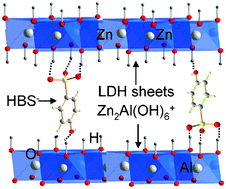A new route for local probing of inner interactions within a layered double hydroxide/benzene derivative hybrid material
Abstract
This paper presents the preparation and characterization of hybrid

* Corresponding authors
a
Université de Pau et des Pays de l’Adour, IPREM CNRS UMR 5254, Helioparc Pau Pyrénées, 2 avenue du président Angot, Pau cedex 9, France
E-mail:
herve.martinez@univ-pau.fr
Fax: +33 (0)5 59407622
Tel: +33 (0)5 59407599
b Laboratoire des Matériaux Inorganiques, UMR CNRS 6002, Université Blaise Pascal and Ecole Nationale Supérieure de Chimie de Clermont-Ferrand, Clermont Université, Aubière Cedex
This paper presents the preparation and characterization of hybrid

 Please wait while we load your content...
Something went wrong. Try again?
Please wait while we load your content...
Something went wrong. Try again?
S. Fleutot, J. C. Dupin, I. Baraille, C. Forano, G. Renaudin, F. Leroux, D. Gonbeau and H. Martinez, Phys. Chem. Chem. Phys., 2009, 11, 3554 DOI: 10.1039/B818730D
To request permission to reproduce material from this article, please go to the Copyright Clearance Center request page.
If you are an author contributing to an RSC publication, you do not need to request permission provided correct acknowledgement is given.
If you are the author of this article, you do not need to request permission to reproduce figures and diagrams provided correct acknowledgement is given. If you want to reproduce the whole article in a third-party publication (excluding your thesis/dissertation for which permission is not required) please go to the Copyright Clearance Center request page.
Read more about how to correctly acknowledge RSC content.
 Fetching data from CrossRef.
Fetching data from CrossRef.
This may take some time to load.
Loading related content
